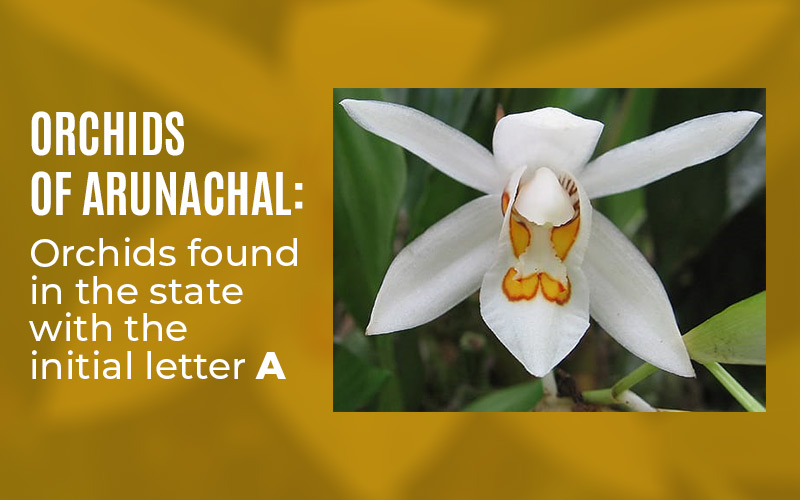
Orchids of Arunachal: Orchids found in the state with the initial letter A
One of the least explored regions of the world, Arunachal
Pradesh has the potential to provide an unforgettable
experience. Witnessing orchids in 'The Orchid State of India' is one such
experience - one can find rare and exotic orchid species in the deep wilderness
of the state or visit orchid preservation centers like Sessa Orchid Sanctuary,
Tippi Orchid, or Dirang Orchid Centers, among others.
This article will attempt to share brief information and highlight a few of the orchids out of more than 622 species of orchids in the state, whose initials start with the Alphabetical letter A.
Acampe ochracea
This genus Acampe of Ochracea species belongs to the family of Orchidaceae, a sub-family of Vandoideae, under the Vandeae tribe and Gastrochilinae subtribe. It is also commonly known as 'The Ochre-Yellow Acampa'. It is an epiphytic plant, having a monopodial habit, whose flowering seasons are Autumn and Winter; the flowering period starts in November and ends in February. It has pale yellow coloured flowers showing a panicle type of inflorescence with a flower size of 1-1.2 cm across.
The species were collected and identified in Arunachal Pradesh from Tipi town by Dr. S. N. Hegde and Dr. A. N. Rao. These species can thrive at an altitude of about 200 m to 1000 m above sea level in the Tropical forests of the state. One can witness this type of specimen preserved at both the Dirang Orchid Center and the Tippi Orchid Center of Arunachal Pradesh.
Acampe papillosa
This orchid species is commonly known as the 'Small Warty Acampe' and is vernacularly known as 'Rasna'. It is one of the epiphytic types of orchids with a characteristic of monopodial plants. Its beautiful yellow with brown striped flowers are about 1 cm in size and have raceme-type inflorescence.
The blooming season of its flowers is Autumn and Winter, from
October to February.
In Arunachal Pradesh, they can be found at an elevation of min 500 m and max 900 m in Tropical forests or preserved in the Tippi Orchid Centre, West Kameng district. The specimens of this species were collected from the sites of Tipi, Sessa and Seijosa by Dr. S. N. Hegde and Dr. A. N. Rao; Dr. Rao is associated with its tissue culture technique.
Aerides multiflora
Commonly named 'The Multi-Flowered Aerides', is a plant of the Orchidaceae family and sub-family of Vandoideae. It belongs to the genus Aerides of multiflora species under the Vandeae tribe and Aeridinae sub-tribe. This monopodial orchid is an epiphytic plant having white with a pink-purplish tinge floral of about size: 2.5 cm across; the season of flower: Spring and Summer (from May to September); it has a woody stem and a raceme inflorescence.
Its type specimens were collected in Arunachal Pradesh from the sites: Tipi; Doimara; Motijeel by: Dr. A. N. Rao; Dr. S. N. Hegde; DST; Dr. J. Nyorak. The orchids can be found at an altitude of 100 m to 1200 m above sea level at the subtropical and tropical forests of Tippi, Doimara, Foot Hills, Motijeel of Arunachal Pradesh, or can be witnessed preservation at Dirang Orchid Centre
Tippi Orchid Centre of the state.
Aerides odorata
Aerides odorata belongs to the genus: Aerides and species: odorata, and is generally dubbed as 'The Fragrant Aerides'. It comes from the Vandeae tribe and Aeridinae subtribe, under the large family of Orchidaceae and subfamily of Vandoideae. It is also vernacularly named Kulap Khao - Ueang Pao - Kulap Krapao Pit in Thailand and Xiang Hua Zhi Jia Lan in China. The orchid blooms in the Spring and Summer seasons from June to December; blossoming white with pinkish-spots coloured flowers of size about 2.2 to 2.5 cm across, a woody stem and a raceme inflorescence.
Aerides odorata is another epiphytic orchid with a monopodial habit whose habitat is at an elevation of a minimum of 100 m and a Maximum of 1000 m. These species prefer forest types such as evergreen and tropical forests such as in the regions: Kameng; Lohit; Siang; Subansiri of Arunachal Pradesh. One can easily find it protected in the Dirang Orchid Centre and Tippi Orchid Centre of the state.
The Sylhet Acanthephippium
Popularly called 'The Sylhet Acanthephippium', comes from the subfamily of Epidendroideae under the Bletieae tribe and Bletiinae subtribe. This species of sylhetense belongs to the genus Acanthephippium, and variety: Acanthephippium curtisii var. albidum; Acanthephippium sylhetense var. pictum. Morphologically, the plant exhibits a fleshy stem, sheaths-covered rhizome, a raceme inflorescence, and a dull-white, blotched with yellow-coloured flowers of size about 2.5-3 cm across. Its flourishing season is Spring with the flowering period starting in April and ending in June.
It is a terrestrial plant with sympodial characteristics that thrive at an elevation of about 1000 m to 1500 m above sea level in tropical forests. Researchers surmise its germplasm availability in the locations such as Siang, Upper Siang, and West Siang etc of Arunachal Pradesh. The orchidarium(s) of the state- Dirang Orchid Centre and Tippi Orchid Centre have preserved their species.
There are plenty of identified species of this useful ornamental plant that we lack awareness of. Hence, to conserve and learn more about the orchids that can be found in Arunachal Pradesh, read Orchids of Arunachal part-1, Orchids of Arunachal part-2, Orchids of Arunachal part-3, Orchids of Arunachal part-4, Orchids of Arunachal part-5, A New Species of Orchid Identified: Schoenorchis mishmensis
Reference(s): www.orchidspecies.com; www.flowersofindia.net;
Orchid Flora of Arunachal Pradesh H. J. Chowdhery 1998; Orchids of Arunachal
Pradesh S. N. Hegde 1984; www.tropicos.org; Flora of China; IOSPE (Internet
Orchid Species Photo Encyclopedia); www.catalogueoflife.org; WCSP: World
Checklist of Selected Plant List.
Disclaimer: The opinions expressed in this article are those of the author's. They do not purport to reflect the opinions or views of The Critical Script or its editor.

Newsletter!!!
Subscribe to our weekly Newsletter and stay tuned.

















Related Comments